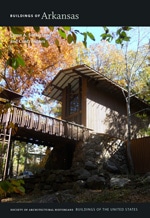The Washington County Courthouse occupied the center of Fayetteville Square from 1837 until the new courthouse (WA8) opened in 1905 on S. College Avenue. The old courthouse was razed, and the square sat empty until 1909 when this post office was constructed. The two-story red brick Georgian Revival building erected from plans by Taylor is detailed in white limestone around the windows and along the dentiled cornice. When the post office outgrew the building, new postal facilities were built in 1963 at the corner of Dickson and St. Charles streets, and after several years of disuse, this building was converted into a restaurant.
You are here
Old U.S. Post Office
If SAH Archipedia has been useful to you, please consider supporting it.
SAH Archipedia tells the story of the United States through its buildings, landscapes, and cities. This freely available resource empowers the public with authoritative knowledge that deepens their understanding and appreciation of the built environment. But the Society of Architectural Historians, which created SAH Archipedia with University of Virginia Press, needs your support to maintain the high-caliber research, writing, photography, cartography, editing, design, and programming that make SAH Archipedia a trusted online resource available to all who value the history of place, heritage tourism, and learning.















